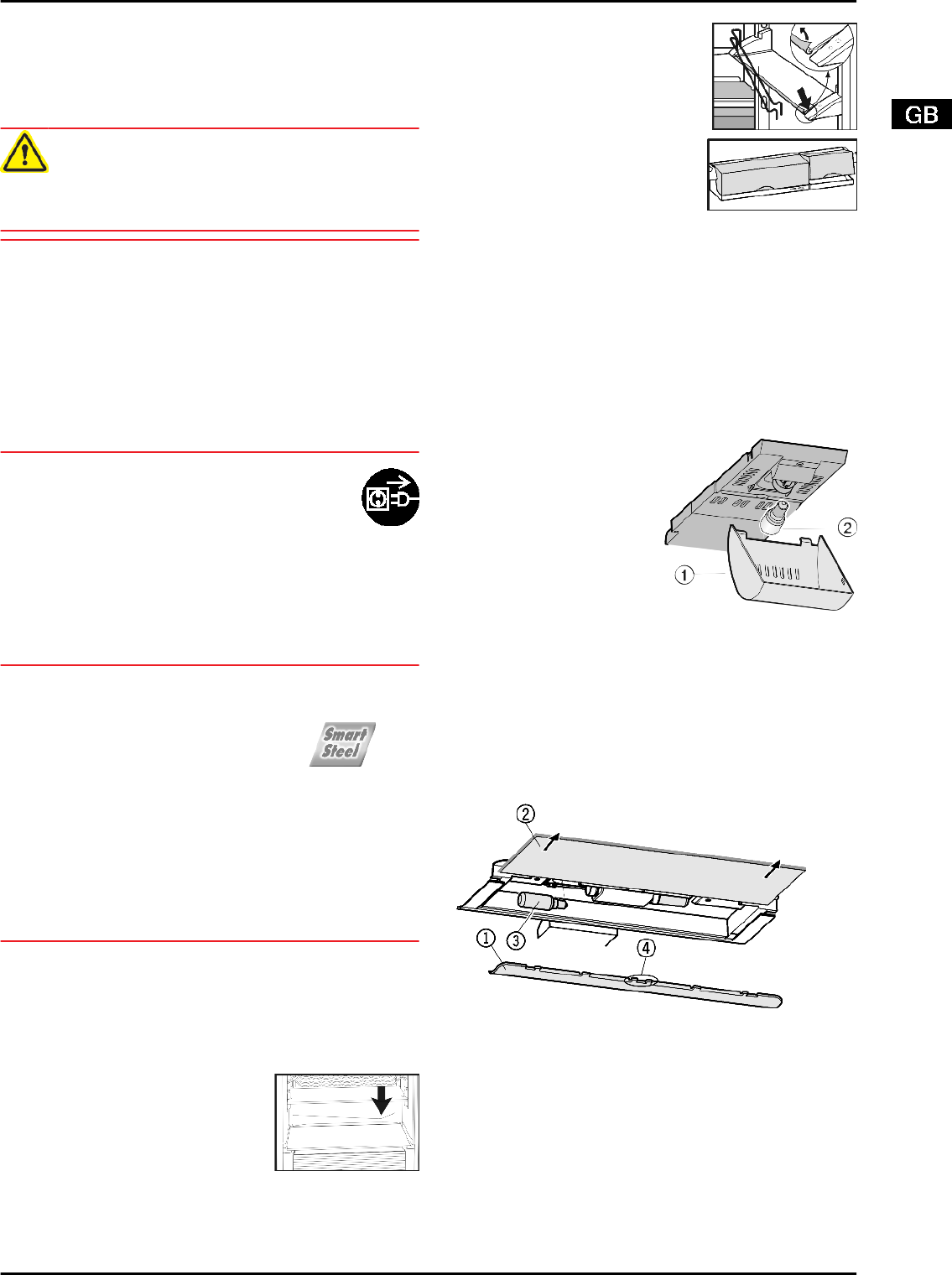
6 Maintenance
6.1 Cleaning the appliance.
Before cleaning:
CAUTION
Risk of injury and damage as a result of hot steam!
Hot steam may damage the surfaces and cause burns.
u
Do not use any steam cleaners!
NOTICE
Incorrect cleaning damages the appliance!
u
Do not use cleaning agents in concentrated form.
u
Do not use any scouring or abrasive sponges or steel wool.
u
Do not use any cleaning agents containing sand, chloride,
chemicals or acid.
u
Do not use chemical solvents.
u
Do not damage or remove the type plate on the inside of the
appliance. It is important for the customer service.
u
Do not pull off, bend or damage cables or other components.
u
Do not allow any cleaning water to enter the drain channel,
ventilation grille or electrical parts.
u
Empty the appliance.
u
Pull out the plug.
- Use soft cleaning cloths and a multi-purpose clean-
ing agent with neutral pH value.
- Only use food compatible cleaning and care agents
on the inside of the appliance.
Outside surfaces and interior:
u
Regularly clean ventilation grilles.
w
Dust deposits increase energy consumption.
u
Clean the plastic surfaces, outside and inside, by hand using
lukewarm water and a little washing-up liquid.
NOTICE
The stainless steel doors have a high-quality surface coating and
must not be cleaned with the accompanying care product.
Otherwise the surface coating will be affected.
u
Wipe the coated door surfaces using a soft, clean cloth only.
In case of stubborn dirt, use a little water or a neutral cleaning
agent. A microfibre cloth can be optionally used.
u
If the stainless steel side walls are dirty, clean them using
a commercially available stainless steel cleaning agent. Then
evenly apply the accompanying stainless steel care product,
making strokes in the direction of the grain.
u
Wipe side walls with a paint finish using a soft, clean cloth
only. In case of stubborn dirt, use a little water or a neutral
cleaning agent. A microfibre cloth can be optionally used.
Clean stainless steel surfaces with a standard stainless steel
cleaning agent. Darker areas at the beginning and quite an in-
tensive colour of the stainless steel surface are normal.
u
Do not apply cleaners to glass or plastic surfaces so as not to
scratch them.
u
To clean stainless steel surfaces: evenly apply an agent for
care of stainless steel, wiping in the direction of the grain.
u
To clean the drain opening: remove
any deposits with a fine instrument,
e.g. a cotton bud.
Items of equipment:
u
Clean items of equipment by hand with lukewarm water and
a little washing-up liquid.
u
To dismantle the shelves: remove the
trims and side parts.
u
To dismantle the storage rack: re-
move the protective film from the dec-
orative trims.
u
Lift out the boxes and lift the covers
for removal.
After cleaning:
u
Wipe dry the appliance and items of equipment.
u
Connect the appliance and switch it on again.
u
Put the food back inside.
6.2 Changing the interior light with bulb
Bulb data
max. 25 W
Fitting: E14
Type of current and voltage must conform with the details on
the type plate
u
Switch off the appliance.
u
Pull out the power plug or
switch off the fuse.
u
Take holder of the cover
Fig. 12 (1)
at the front and
unhook it at the back.
u
Change the bulb
Fig. 12 (2)
.
u
Put the cover
Fig. 12 (1)
back in place.
Fig. 12
6.3 Changing the interior light with bulb
Bulb data
T25 tube, Philips
max. 25 W
Fitting: E14
Type of current and voltage must conform with the details on
the type plate
Fig. 13
u
Switch off the appliance.
u
Pull out the power plug or switch off the fuse.
u
To remove the cover
Fig. 13 (1)
: put your finger behind the
cover and disengage it.
u
Pull out the glass shelf
Fig. 13 (2)
.
u
Change the bulb
Fig. 13 (3)
.
u
Slide the glass shelf back in.
u
Attach the cover again, engage it at the right and left and pay
attention that the middle hook
Fig. 13 (4)
grips over the glass
shelf.
Maintenance
9














